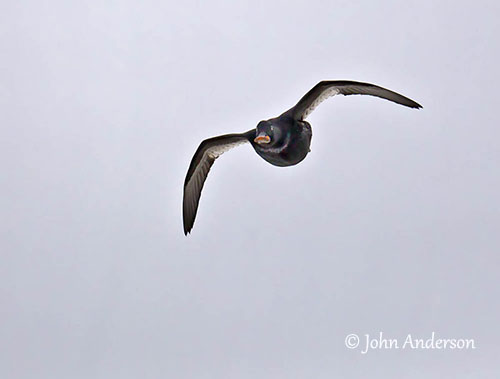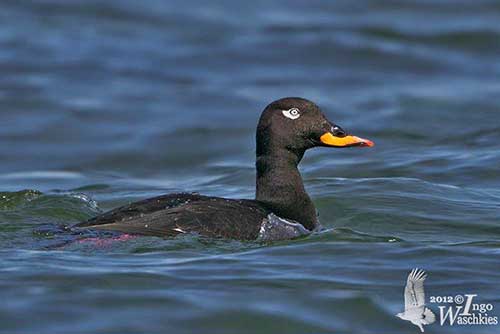
Fr: Macreuse brune
Ang: Velvet Scoter
All: Samtente
Esp: Negrón especulado
Ita: Orco marino
Nd: Grote Zee-eend
Sd: Svärta
Photographers:
John Anderson
John Anderson Photo Galleries
Steve Garvie
RAINBIRDER Photo galleries & Flickr Rainbirder
Otto Plantema
Trips around the world
Ingo Waschkies
My bird pictures on Pbase
Text by Nicole Bouglouan
Sources:
HANDBOOK OF THE BIRDS OF THE WORLD vol 1 by Josep del Hoyo-Andrew Elliot-Jordi Sargatal - Lynx Edicions - ISBN: 8487334105
THE COMPLETE BOOK OF BRITISH BIRDS – Written by “Royal Society for the Protection of Birds” experts - Préface de Magnus Magnusson - Michael Cady- Rob Hume Editors - ISBN: 0749509112
THE HANDBOOK OF BIRD IDENTIFICATION FOR EUROPE AND THE WESTERN PALEARCTIC by Mark Beaman, Steve Madge - C. Helm - ISBN: 0713639601
GUIDE DES CANARDS, DES OIES ET DES CYGNES – de Steve Madge - Delachaux et Niestlé - ISBN: 2603013769
SoftScools.com – Velvet Scoter Facts
Wikipedia, the free encyclopaedia
Velvet Scoter
Melanitta fusca
Anseriformes Order – Anatidae Family
INTRODUCTION:
The Velvet Scoter is a large sea duck breeding in N Europe and Asia W of the Yenisei Basin. It is now a monotypic species since the White-winged Scoter (M. deglandi) is considered a separate species.
The Velvet Scoter is bigger and bulkier than the Common Scoter (M. nigra), and both species sometimes occur in mixed flocks. Outside the breeding season, it becomes a marine species and occurs in shallow water along the littoral zone in more temperate regions.
This species is threatened by oil spills at sea and by degradation of the habitat on the breeding grounds. Disturbance, hunting and predation by terrestrial mammals involve decline of population, and the species is currently classified as Vulnerable.

DESCRIPTION OF THE BIRD:
Biometrics:
Length: 51-58 cm
Wingspan: 86-99 cm
Weight: M: 1173-2104 g – F: 1140-1895 g
The Velvet Scoter adult male has glossy blackish plumage overall, becoming duller outside the breeding season, with pale-mottled flanks.
In flight, we can see a conspicuous white wingbar formed by the white secondaries and the greater coverts. This patch is less visible on closed wings.
On the head, there is a white croissant-shaped eye patch below the eye.
The bill is yellow or yellow-orange, with pinkish-orange or reddish-orange nail. Both knob and cutting edges are black. A thin black line can be seen on the sides of the culmen. The eyes are pale grey. Legs and webbed feet are pinkish with blackish webs.
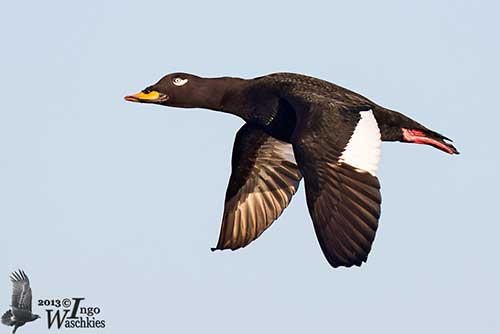
The adult female is dark brown with one or two circular whitish patches on head side. The bill is dull blackish or dark grey. The eyes are brown. Legs and feet are dull reddish.
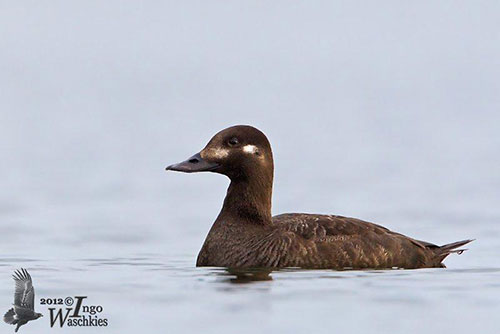
The juvenile resembles female but it has larger head patches and paler breast. The bill becomes coloured during early spring, but it lacks the basal knob of the adult. The young male is usually dull brown to black, with variable black mottling on the upperparts.
RANGE:
The Velvet Scoter breeds in Scandinavia and Estonia, E to R Yenisei, C Siberia S to Kazakhstan. There are some isolated populations in Turkey, Armenia and Georgia.
It winters at sea along the coasts of W Europe S to N Mediterranean, and can be seen in Black and Caspian Seas too.
HABITAT:
The Velvet Scoter breeds near lakes and large pools in boreal forest and Arctic tundra, and locally further south by wooded and rocky shores of Baltic Sea, and open upland lakes in E Turkey and Transcaucasia, up to 3000 metres of elevation.
On passage, it can be seen in estuaries and on freshwater lakes.
It winters in coastal waters, and occasionally in small numbers on inland lakes.
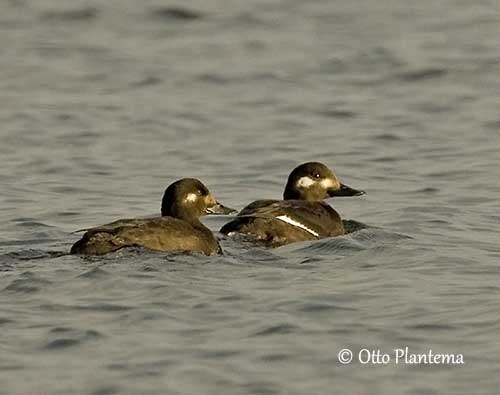
CALLS AND SONGS: SOUNDS BY XENO-CANTO
The Velvet Scoter is usually largely silent away from the breeding grounds. During displays, the male gives a loud, piping call “vak-vak” while the female utters a harsh “karr”. Both calls are also given in flight.
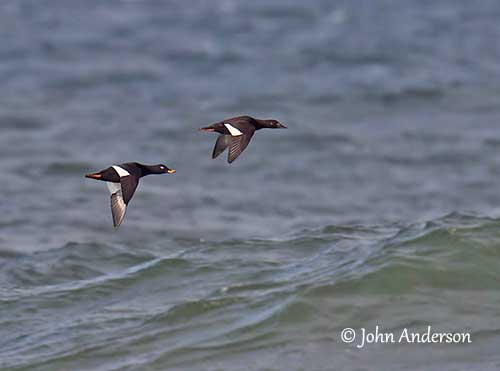
BEHAVIOUR IN THE WILD:
The Velvet Scoter feeds mainly on saltwater molluscs and crustaceans during winter, including blue mussels, cockles, and benthic molluscs. The selected preys are more than 30 millimetres in size.
During the breeding season, it feeds primarily on aquatic insect larvae, but it also takes crustaceans, worms, echinoderms and small fish. It may feed on some plant material on the breeding grounds.
The Velvet Scoter feeds mainly by diving. It uses both wings and webbed feet to propel itself underwater. It dives with partially open wings but with no jump. It may forage at night farther from shores and in deeper waters, even in winter.
In some parts of the winter range, it feeds on echinoderms extracted from sandy substrate at the bottom in SW Norway.
The Velvet Scoter is seasonally monogamous, and the pair probably forms during the migration.
Like all Anatidae, several males court a single female. They lower the head and arch the back before rushing forwards over short distance on water surface. Some chases are reported too. Preening often occurs prior to copulation.
The pair is territorial and often defends a small territory around the nest-site.
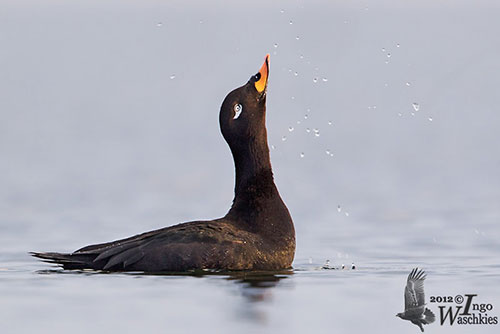
The Velvet Scoter is migratory. The birds gather in large flocks for moulting before to move to their wintering areas. Many movements occur at night. Exceptional formation of sea-ice may disturb and displace large numbers, especially in E Baltic. The species may wander to Greenland. The return to the breeding grounds starts in early March, with large flocks in Danish waters until mid-May.
The Velvet Scoter flies with the neck held rigidly outstretched, not dropped as in Common Scoter. The white wing patch is conspicuous in flight.
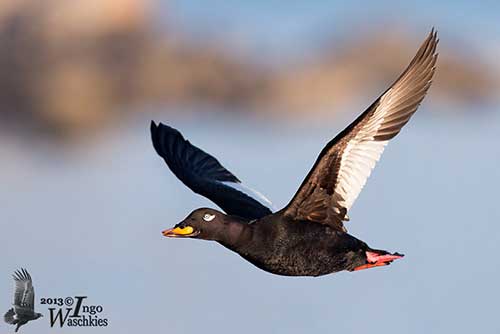
REPRODUCTION OF THIS SPECIES:
The breeding season starts in May/June. The Velvet Scoter nests in single pairs or loose groups, especially on islands in SW Finland, and in wooded boreal and taiga area.
The nest is a shallow depression on the ground, lined with down and surrounding plant matter. It is placed among the vegetation within 100 metres from open water, sometimes up to 2-3 kilometres.
The female lays 7-9 creamy-buff eggs and incubates alone during 26-29 days. The male leaves soon after the beginning of the incubation. At hatching, the chicks have dark brown down above, and white cheeks, neck sides, lower throat and underparts. They leave the nest soon after hatching and feed themselves. They are brooded at night by female during 1-3 weeks, and she leaves them at this period. They fledge between 50 and 55 days after hatching.
This species produces a single brood per season.
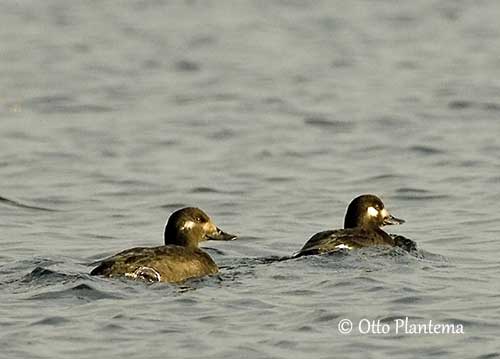
PROTECTION / THREATS / STATUS:
The Velvet Scoter is threatened by oil spills and marine pollutants while moulting and during winter. It is also threatened by fishing nets, by impact of commercial exploitation of marine benthic organisms and shellfish, and by habitat degradation by exploitation of natural resources in the taiga and lower tundra regions in the breeding range. In addition, they suffer from predation by American vison (Neovison vison) on islands and hunting in some areas.
The total population was estimated at 450,000 individuals in 2012, and it is still decreasing.
The Velvet Scoter is currently classified as Vulnerable.
